Government Control of Money 1. 1. Legal

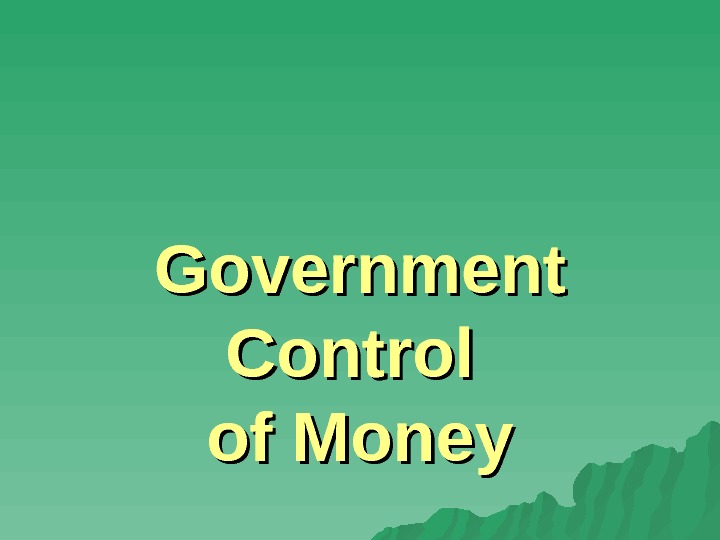
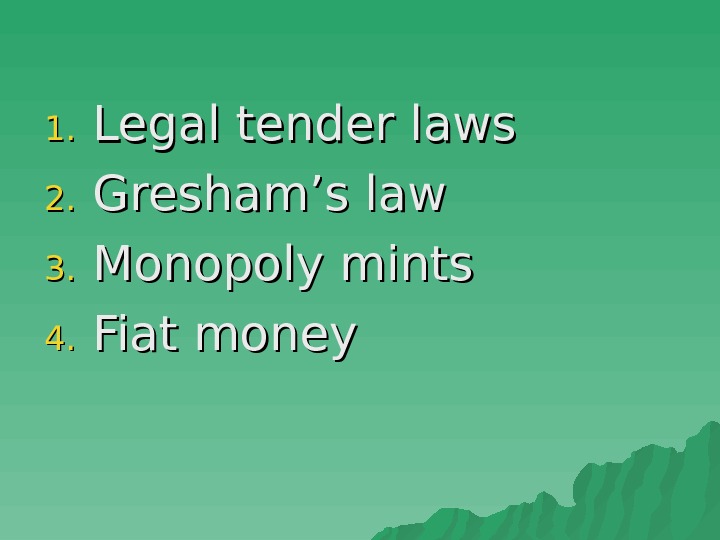
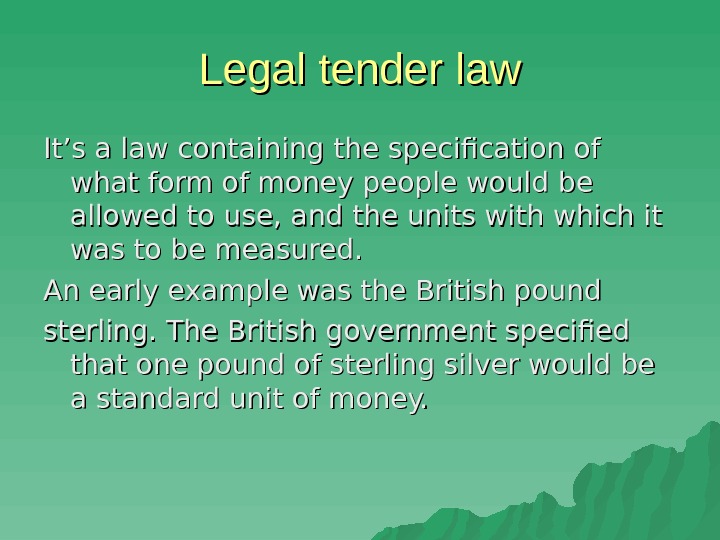
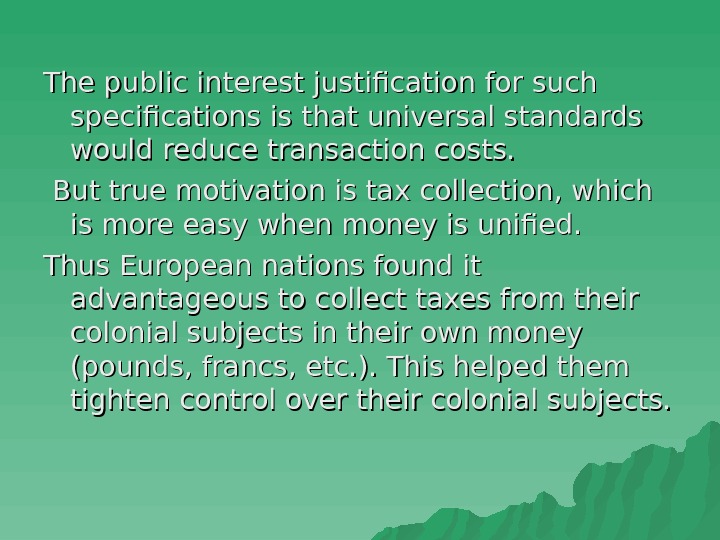
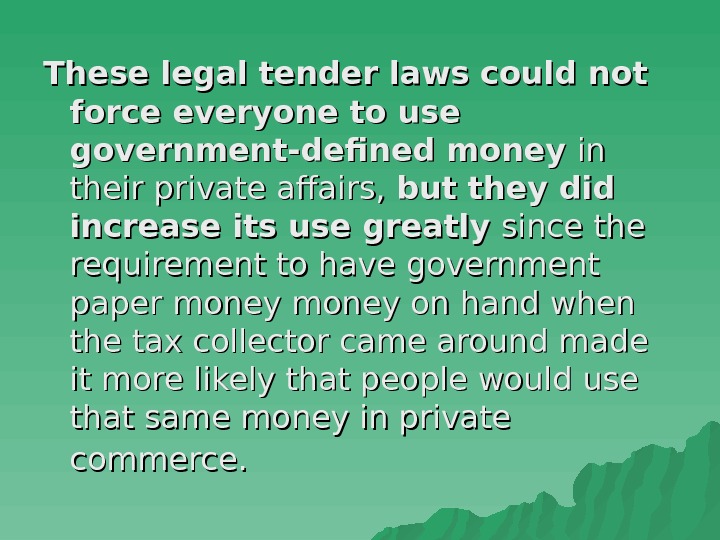
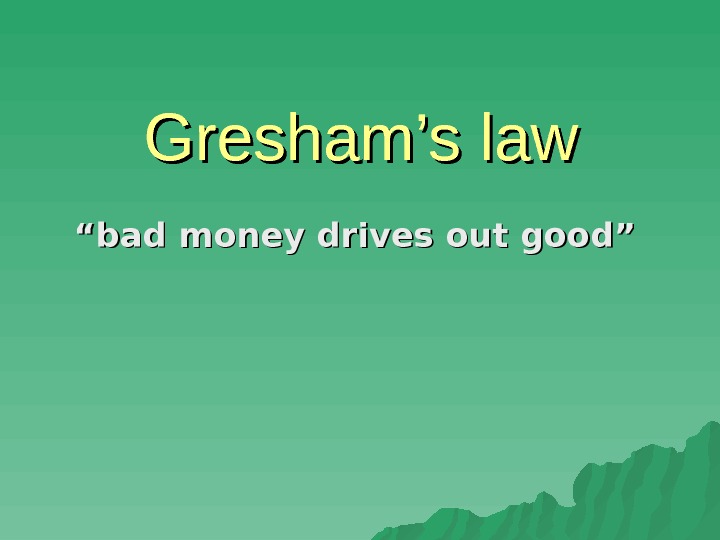
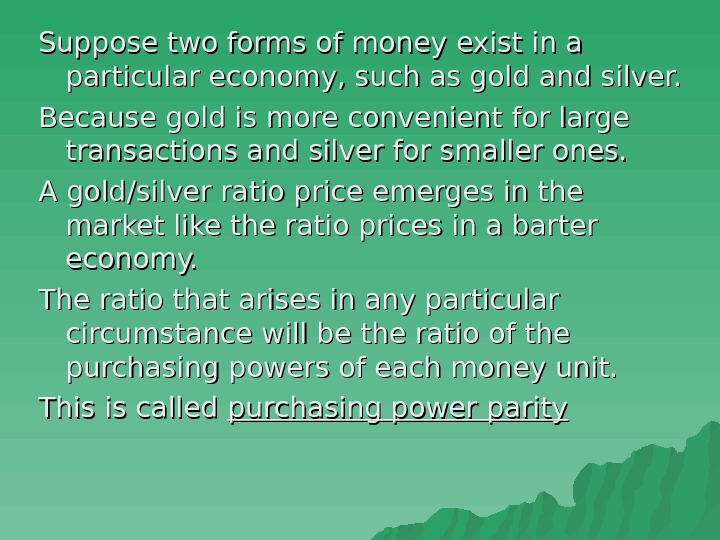
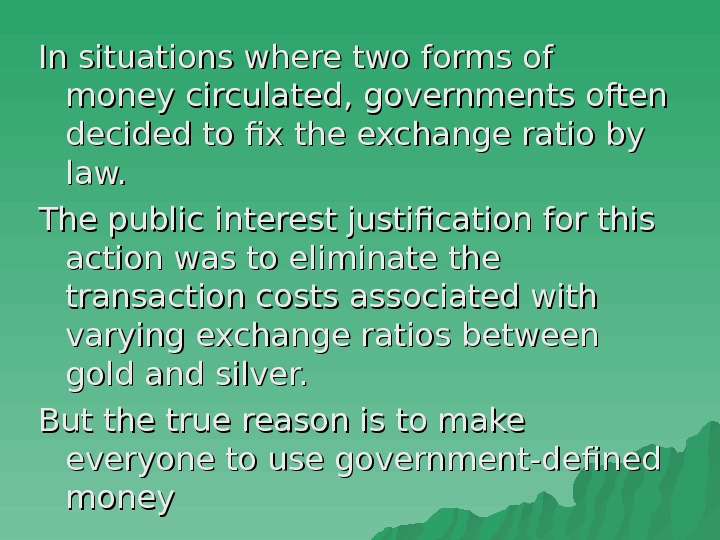
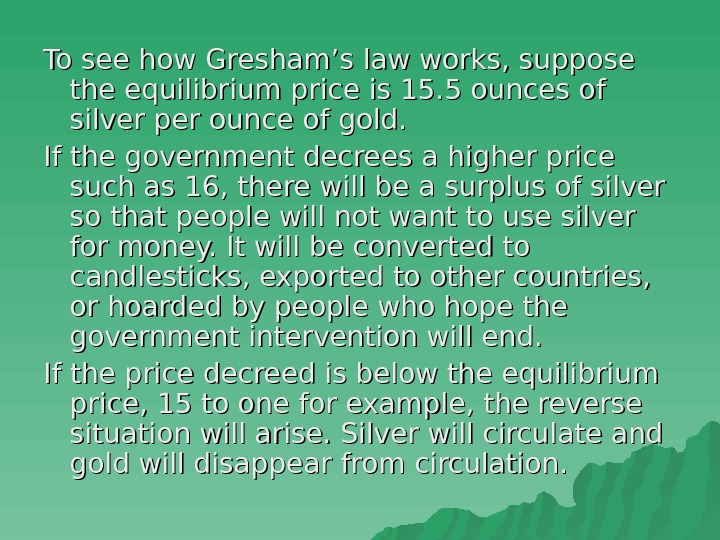
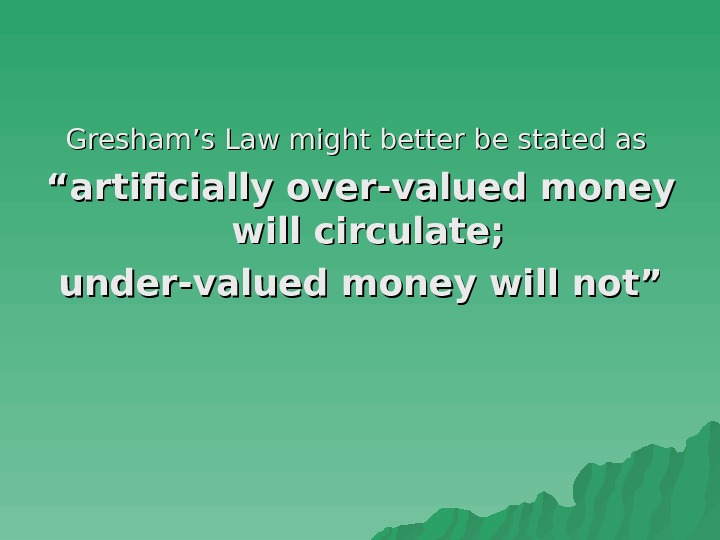
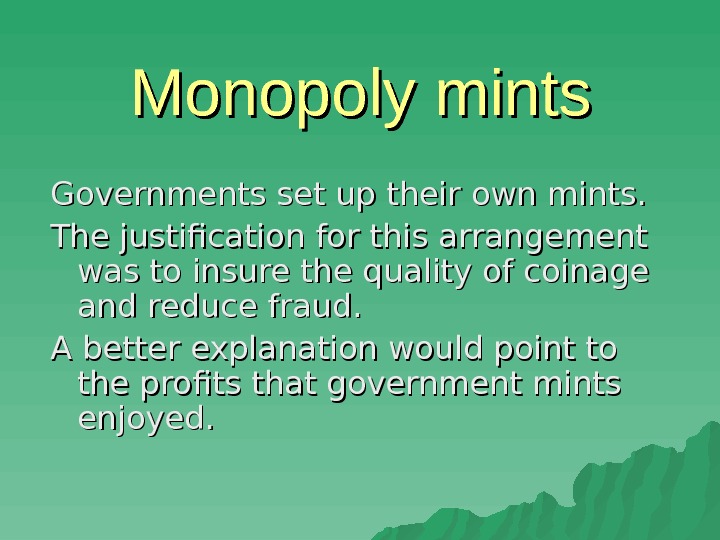
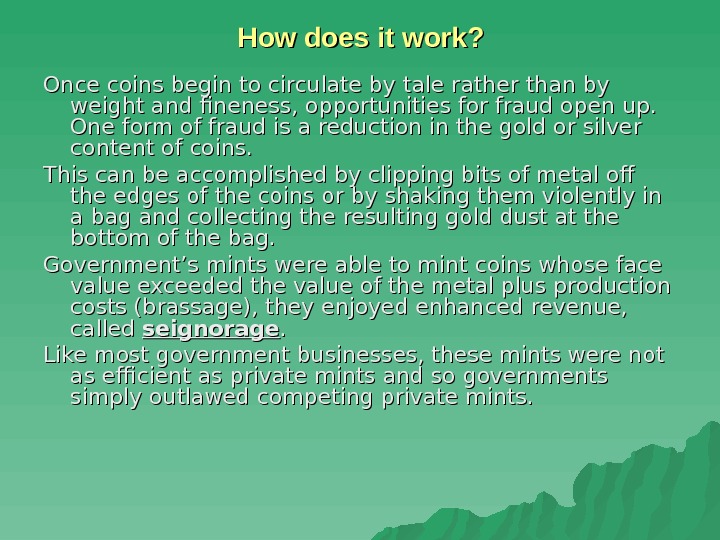
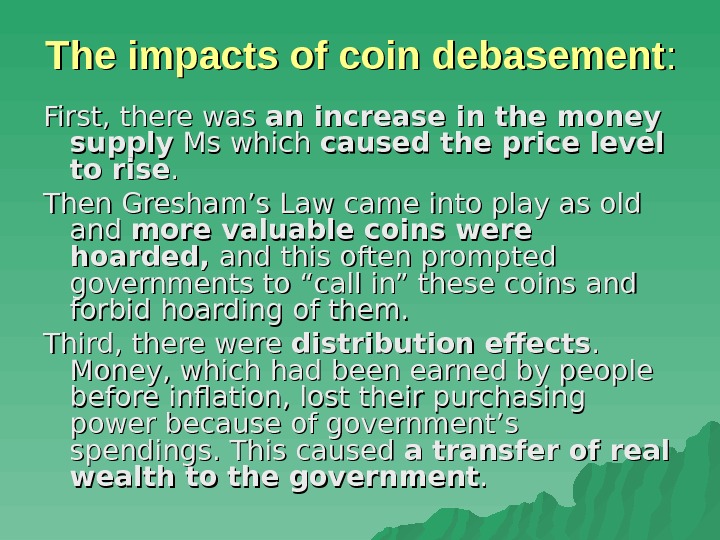
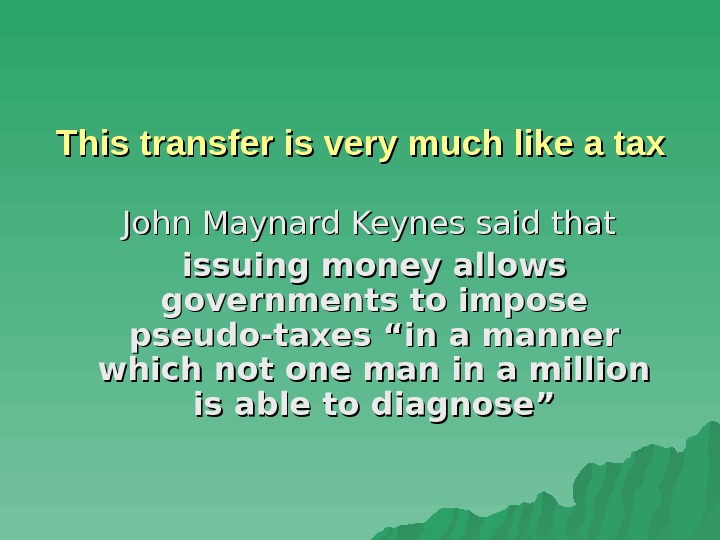
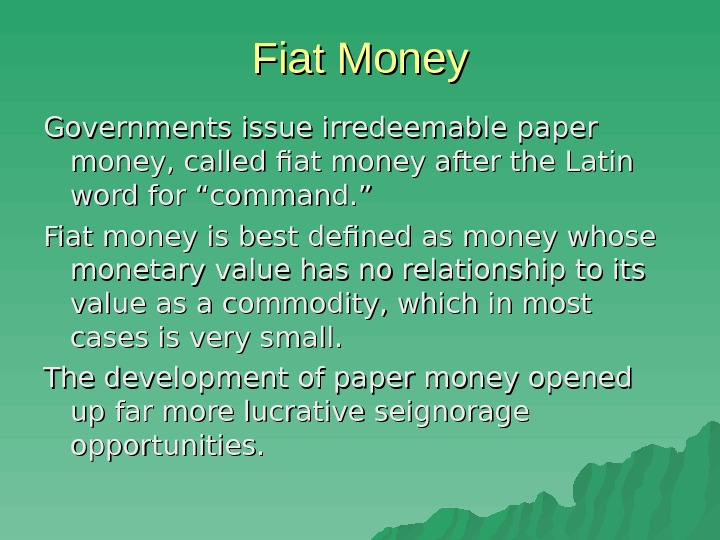
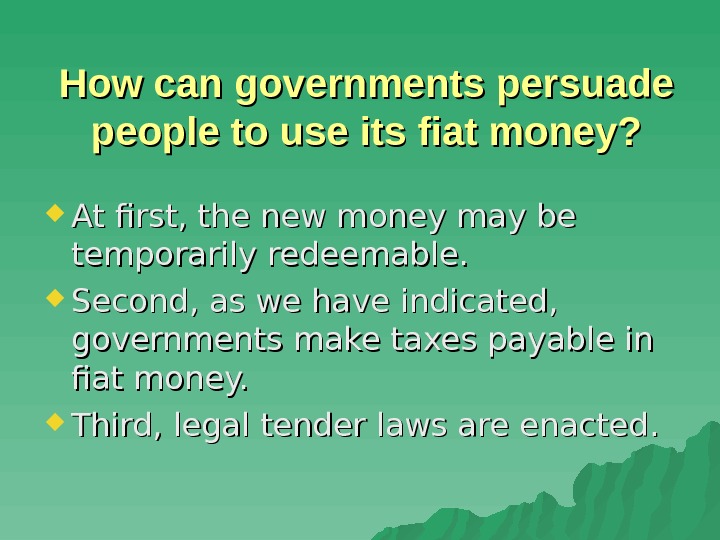
- Размер: 98 Кб
- Количество слайдов: 16
Описание презентации Government Control of Money 1. 1. Legal по слайдам
 Government Control of Money
Government Control of Money
 1. 1. Legal tender laws 2. 2. Gresham’s law 3. 3. Monopoly mints 4. 4. Fiat money
1. 1. Legal tender laws 2. 2. Gresham’s law 3. 3. Monopoly mints 4. 4. Fiat money
 Legal tender law It’s a law containing the specification of what form of money people would be allowed to use, and the units with which it was to be measured. An early example was the British pound sterling. The British government specified that one pound of sterling silver would be a standard unit of money.
Legal tender law It’s a law containing the specification of what form of money people would be allowed to use, and the units with which it was to be measured. An early example was the British pound sterling. The British government specified that one pound of sterling silver would be a standard unit of money.
 The public interest justification for such specifications is that universal standards would reduce transaction costs. But true motivation is tax collection, which is more easy when money is unified. Thus European nations found it advantageous to collect taxes from their colonial subjects in their own money (pounds, francs, etc. ). This helped them tighten control over their colonial subjects.
The public interest justification for such specifications is that universal standards would reduce transaction costs. But true motivation is tax collection, which is more easy when money is unified. Thus European nations found it advantageous to collect taxes from their colonial subjects in their own money (pounds, francs, etc. ). This helped them tighten control over their colonial subjects.
 These legal tender laws could not force everyone to use government-defined money in in their private affairs, but they did increase its use greatly since the requirement to have government paper money on hand when the tax collector came around made it more likely that people would use that same money in private commerce.
These legal tender laws could not force everyone to use government-defined money in in their private affairs, but they did increase its use greatly since the requirement to have government paper money on hand when the tax collector came around made it more likely that people would use that same money in private commerce.
 Gresham’s law ““ bad money drives out good”
Gresham’s law ““ bad money drives out good”
 Suppose two forms of money exist in a particular economy, such as gold and silver. Because gold is more convenient for large transactions and silver for smaller ones. A gold/silver ratio price emerges in the market like the ratio prices in a barter economy. The ratio that arises in any particular circumstance will be the ratio of the purchasing powers of each money unit. This is called purchasing power parity
Suppose two forms of money exist in a particular economy, such as gold and silver. Because gold is more convenient for large transactions and silver for smaller ones. A gold/silver ratio price emerges in the market like the ratio prices in a barter economy. The ratio that arises in any particular circumstance will be the ratio of the purchasing powers of each money unit. This is called purchasing power parity
 In situations where two forms of money circulated, governments often decided to fix the exchange ratio by law. The public interest justification for this action was to eliminate the transaction costs associated with varying exchange ratios between gold and silver. But the true reason is to make everyone to use government-defined money
In situations where two forms of money circulated, governments often decided to fix the exchange ratio by law. The public interest justification for this action was to eliminate the transaction costs associated with varying exchange ratios between gold and silver. But the true reason is to make everyone to use government-defined money
 To see how Gresham’s law works, suppose the equilibrium price is 15. 5 ounces of silver per ounce of gold. If the government decrees a higher price such as 16, there will be a surplus of silver so that people will not want to use silver for money. It will be converted to candlesticks, exported to other countries, or hoarded by people who hope the government intervention will end. If the price decreed is below the equilibrium price, 15 to one for example, the reverse situation will arise. Silver will circulate and gold will disappear from circulation.
To see how Gresham’s law works, suppose the equilibrium price is 15. 5 ounces of silver per ounce of gold. If the government decrees a higher price such as 16, there will be a surplus of silver so that people will not want to use silver for money. It will be converted to candlesticks, exported to other countries, or hoarded by people who hope the government intervention will end. If the price decreed is below the equilibrium price, 15 to one for example, the reverse situation will arise. Silver will circulate and gold will disappear from circulation.
 Gresham’s Law might better be stated as ““ artificially over-valued money will circulate; under-valued money will not”
Gresham’s Law might better be stated as ““ artificially over-valued money will circulate; under-valued money will not”
 Monopoly mints Governments set up their own mints. The justification for this arrangement was to insure the quality of coinage and reduce fraud. A better explanation would point to the profits that government mints enjoyed.
Monopoly mints Governments set up their own mints. The justification for this arrangement was to insure the quality of coinage and reduce fraud. A better explanation would point to the profits that government mints enjoyed.
 How does it work? Once coins begin to circulate by tale rather than by weight and fineness, opportunities for fraud open up. One form of fraud is a reduction in the gold or silver content of coins. This can be accomplished by clipping bits of metal off the edges of the coins or by shaking them violently in a bag and collecting the resulting gold dust at the bottom of the bag. Government’s mints were able to mint coins whose face value exceeded the value of the metal plus production costs (brassage), they enjoyed enhanced revenue, called seignorage. . Like most government businesses, these mints were not as efficient as private mints and so governments simply outlawed competing private mints.
How does it work? Once coins begin to circulate by tale rather than by weight and fineness, opportunities for fraud open up. One form of fraud is a reduction in the gold or silver content of coins. This can be accomplished by clipping bits of metal off the edges of the coins or by shaking them violently in a bag and collecting the resulting gold dust at the bottom of the bag. Government’s mints were able to mint coins whose face value exceeded the value of the metal plus production costs (brassage), they enjoyed enhanced revenue, called seignorage. . Like most government businesses, these mints were not as efficient as private mints and so governments simply outlawed competing private mints.
 First, there was an increase in the money supply Ms which caused the price level to rise. . Then Gresham’s Law came into play as old and more valuable coins were hoarded, and this often prompted governments to “call in” these coins and forbid hoarding of them. Third, there were distribution effects. . Money, which had been earned by people before inflation, lost their purchasing power because of government’s spendings. This caused a transfer of real wealth to the government. . The impacts of coin debasement : :
First, there was an increase in the money supply Ms which caused the price level to rise. . Then Gresham’s Law came into play as old and more valuable coins were hoarded, and this often prompted governments to “call in” these coins and forbid hoarding of them. Third, there were distribution effects. . Money, which had been earned by people before inflation, lost their purchasing power because of government’s spendings. This caused a transfer of real wealth to the government. . The impacts of coin debasement : :
 John Maynard Keynes said that issuing money allows governments to impose pseudo-taxes “in a manner which not one man in a million is able to diagnose”This transfer is very much like a tax
John Maynard Keynes said that issuing money allows governments to impose pseudo-taxes “in a manner which not one man in a million is able to diagnose”This transfer is very much like a tax
 Fiat Money Governments issue irredeemable paper money, called fiat money after the Latin word for “command. ” Fiat money is best defined as money whose monetary value has no relationship to its value as a commodity, which in most cases is very small. The development of paper money opened up far more lucrative seignorage opportunities.
Fiat Money Governments issue irredeemable paper money, called fiat money after the Latin word for “command. ” Fiat money is best defined as money whose monetary value has no relationship to its value as a commodity, which in most cases is very small. The development of paper money opened up far more lucrative seignorage opportunities.
 At first, the new money may be temporarily redeemable. Second, as we have indicated, governments make taxes payable in fiat money. Third, legal tender laws are enacted. How can governments persuade people to use its fiat money?
At first, the new money may be temporarily redeemable. Second, as we have indicated, governments make taxes payable in fiat money. Third, legal tender laws are enacted. How can governments persuade people to use its fiat money?

